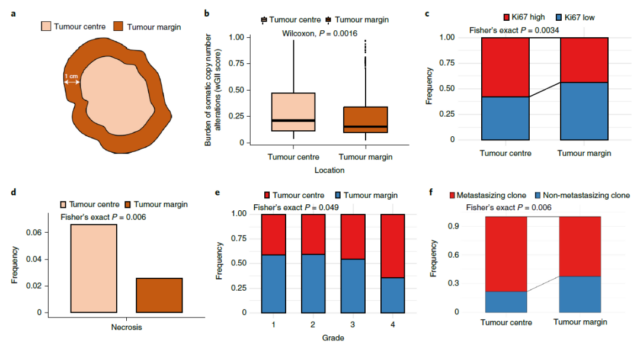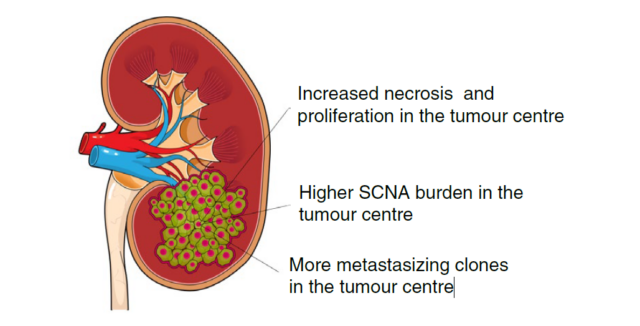Cancer cells in tumor center are the easiest to spread throughout the body
- Aspirin: Study Finds Greater Benefits for These Colorectal Cancer Patients
- Cancer Can Occur Without Genetic Mutations?
- Statins Lower Blood Lipids: How Long is a Course?
- Warning: Smartwatch Blood Sugar Measurement Deemed Dangerous
- Mifepristone: A Safe and Effective Abortion Option Amidst Controversy
- Asbestos Detected in Buildings Damaged in Ukraine: Analyzed by Japanese Company
Cancer cells in the tumor center are the easiest to spread throughout the body
Cancer cells in tumor center are the easiest to spread throughout the body. They suffer from the harshest environment and are therefore more powerful.
As we all know, a distinguishing feature of cancer cells is that they are very aggressive, so they are easy to metastasize and spread to other parts of the body. Cancer cells that have metastasized in the past develop into secondary tumors, which also makes cancer treatment more difficult. Further understanding of the specific mechanism of this metastasis and spread of cancer cells will help prevent their metastasis and spread, and then develop new treatment methods.
For solid tumors, cancer cells form dense solid tumors. As the tumor grows, it is difficult to get enough blood supply inside the tumor, which leads to the hypoxic environment inside the solid tumor.
On May 17, 2021, researchers from the Francis Crick Institute/University College London published a research paper titled: Selection of metastasis competent subclones in the tumour interior in the journal Nature Ecology & Evolution.
The study observed the behavior of cancer cells from different parts of the kidney tumor. It was surprisingly found that cancer cells at the edge of the tumor have a lower metastasis rate, growth rate, and genetic damage rate, while cancer cells located in the center of the tumor have lower The genome is more unstable, they are the most aggressive, and have the highest probability of spreading in the human body.
In order to better understand the genomic and spatial basis of tumor evolution, the research team of the Francis Crick Institute and University College London has launched a large-scale research project called TRACERx to track the evolution of cancer through therapy, which has been published previously. Research results including lung cancer.
This time, the research team focused on kidney cancer research. The research team analyzed 756 cancer biopsy samples from different areas of kidney tumors and compared them with 79 metastatic biopsy samples from 32 renal clear cell carcinomas through high-throughput sequencing.
The results showed that compared with tumor marginal cells, the necrosis and proliferation of cancer cells in the center of the tumor increased, the burden of somatic copy number changes (SCNA) of cancer cells in the center of the tumor increased, and cancer cells in the center of the tumor had more metastases. Sexual cloning.
This indicates that compared with cancer cells at the edge of the tumor, the cancer cell genome in the center of the tumor is more unstable, grows faster, and is easier to metastasize and spread.


Regarding these findings, the main leader of the study, Professor Kevin Litchfield of the Institute of Cancer Research at University College London, said that cancer cells located in the center of the tumor lack blood and oxygen supplies and often face more severe environmental conditions. This makes them have to become stronger and more active in order to adapt to the pressure of survival. Therefore, it is more likely to evolve the ability to transfer to other organs and tissues and survive successfully in them.
These findings remind us that we need to pay close attention to the tumor center to understand how the cancer spreads and discover the cancer cells that are the greatest threat to cancer patients. This also shows the importance of developing treatments that target the unique environmental conditions in the tumor center to successfully eliminate the most aggressive cancer cells.
The research team also studied how the genetically heterogeneous cancer cell population grows within the tumor. The research team used a unique map-building tool to reconstruct the growth of tumor cells. They found that although most tumors follow the pattern of growing locally and do not move like plants, a few will jump in a way similar to “jumping” Go to other areas and dominate. The research team is planning to reconstruct the 3D tumor map to provide a clearer visualization of the spatial pattern within the tumor.
Professor Samra Turajlic, head of the Francis Crick Cancer Dynamics Laboratory and principal investigator of TRACERx Renal, said: Cancer spread is one of the biggest obstacles to improving survival. The TRACERx Renal project has solved the genetic composition of different areas in the tumor , But until now, I have not been able to understand the spatial relationship of these differences. The most critical problem is that cancer cells will split out of the tumor and metastasize to other parts, making the cancer incurable.
With the TRACERx Renal project, it is now possible to pinpoint the location of genetic disorder in tumors that causes metastasis. The observation results also revealed the environmental conditions that promote tumor aggressiveness-the ischemic and hypoxic environment within the tumor. These findings provide a key basis for targeting and preventing the most metastatic and spreading cell population in tumors.
(source:internet, reference only)
Disclaimer of medicaltrend.org



